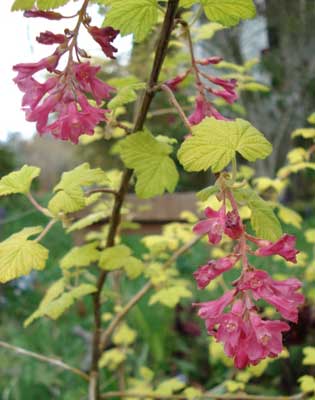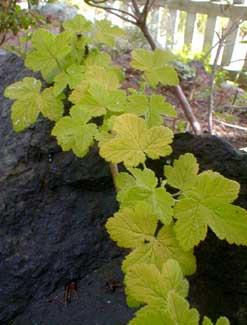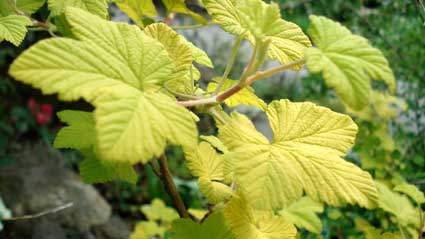
'Brocklebankii'
Golden Currant
"When the quiet with a ring of pearl shall wed the earth,
And the scarlet berries burn dark by the stars in the pool;
Oh, it's lost & deep I'll be amid the Danaan mirth,
While the heart of the earth is full."
-"A. E."
(George William Russell, 1867‚1935)
(George William Russell, 1867‚1935)
 We obtained a Golden Currant (Ribes sanguineum 'Brocklebankii') from Heronswood nursery, started from a seed in 2001, & planted it in our garden in May 2004.
We obtained a Golden Currant (Ribes sanguineum 'Brocklebankii') from Heronswood nursery, started from a seed in 2001, & planted it in our garden in May 2004.It had taken two full years in greenhouse conditions to become about a ten inch one-limb shrub, so we prepared ourselves for it to be vastly more slow-growing than 'King Edward VII' red flowering currant & 'White Icicle' white flowering currant.
'Brocklebankii' will eventually grow three to five feet, potentially taller, but generally less than half the size of the wild flowering currant. After one year it was still quite small, the initial ten-inch limb reaching to almost two feet but only one other branch. That initial limb or would-be "trunk" is shown in the second photo here at the right.
By 2008/2008, we had a very nice little shrub with light pink flowers in May, as in the first photo above. Young leaves on 'Brocklebankii' are golden-yellow (as in the third photo snapped in April), aging in summer to chartreuse. The pale leaves are more sensitive to excessive sunlight & heat than are flowering currents with green leaves, so it prefers a bit of shade during the day.
 The perfect partial-shade position can be a puzzle, since it does need good sun to flower well, but the golden leaves & pale bark will sunburn if not protected from from too much light exposure through hottest days of summer. It needs regular watering even though it is surprisingly drought tolerant when well established.
The perfect partial-shade position can be a puzzle, since it does need good sun to flower well, but the golden leaves & pale bark will sunburn if not protected from from too much light exposure through hottest days of summer. It needs regular watering even though it is surprisingly drought tolerant when well established.Our little start was rather prostrate in the direction of its growth. Finding a good location for it where it gave a pleasing impression while still tiny, but where it would still fit nicely when it matured, was an additional puzzle. I finally placed it in a semi-shade perennial garden partially shaded by the Pin Oak, leaning its half-prostrate main section over a large black jade rock toward morning sunlight.
The golden leaves against the black jade looked quite nice even for such a small thing. As it matured, it got a little taller & a lot bushier, but other perennials including somewhat thuggish Japanese anemones are not apt ever to be shoved aside.
Pendant clusters of flowers are pale rose-pink in late winter or early spring. The first flowers are forming just as leaves are emerging, & are still fresh-looking when the leaves are fully developed. Late spring & early summer fruit is black but so far never much.
The Royal Horticulatural Society bestowed upon 'Brocklebankii' the Award of Garden Merit for beauty & ease of growing. Although the species is native of the Pacific Northwest, this cultivar was developed in the UK, where it is a much more common nursery offering than it has been in the United States.